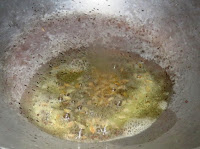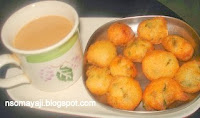Watermelon fruit is plenty in the market. Summer and Water Mellon go hand in hand. You all agree with my words. Water Melon keeps us cool. It is full of water and quenches our thirst, most of them know about it. How about using its rind in our kitchen ? Have you given a try ?
There are so many dishes that we can prepare using this rind. Use the rind of watermelon fruit and get the benefits. Here is a curry with Watermelon rind. Prepare it and enjoy.
This time it is with Avarekai (Field Beans) and tomatoes. No coconut or dal in this curry. (Avarekalu is used instead of toor/moong dal.
Lets see some benefits of Watermelon Rind :
Watermelon rind also got a healthy amount of Vitamin A, Vitamin C, potassium. magnesium and other important nutrients. It is very good in controlling blood pressure. They are good for eradicating prostrate and they help to keep our urinary tract in healthy condition. They are good for our skin and good for our nervous system. They are loaded with amino acids and anti oxidants and they protect us from free radical damages, circulatory system and immune system.
Onions and garlic are not used in this "Avarekai- Watermelon Rind Curry'. You can have this curry with almost all main dishes like plain rice, chapatis, idli, dosa, poori etc etc etc...
Lets see the recipe now :
Watermelon rind : 1 big bowl grated. (3 to 4 big pieces).
Tomatoes : 2 to 3 (medium size)
Avarekai/Field beans : 1 Bowl (1 Cup pods)
To Add :
Rasam/Sambar Powder : 2 to 3 Teaspoons
Green chilly : 2
Ginger : Grated : 1 Tablespoon
Coriander Leaves : 2 Tablespoons
Lemon juice (Extract) : 1 Teaspoon (1/2 Lemon)
Methi/Fenugrik seeds : 1/4 Teaspoon
Salt : required salt
Turmeric powder : a pinch
Seasoning :
Oil : 1 Teaspoon (Any cooking oil)
Mustard seeds : 1/2 Teaspoon
Jeera/Cumin Seeds : 1/2 Teaspoon
Ingh : a pinch
Curry Leaves : 5 to 6
2. Wash and remove the green part (outer skin) of watermelon rind and grate the rind and keep it aside.
3. Wash and cut tomatoes into thin pieces and keep it aside. Slit green chilly into two.
4. Now keep a pan and heat. Add mustard seeds and let it splutter. Add jeera and curry leaves.
5. Add ingh and green chilly and fry for 10 seconds. Add cut tomatoes, turmeric powder and fry nicely till it turns soft. Add grated ginger. Add methi seeds.
6. Now add Grated watermelon rind, cooked Avarekai. Add required salt.
7. Mix it well and let it cook for 2 to 3 minutes.
8. Now add sambar powder and mix it nicely and let it boil for 2 minutes. Add lemon juice.
9. Shift the curry into a serving bowl, add cut coriander leaves and serve the main dish you have prepared.
Time : 30 minutes
Serves : 3 to 4
There are so many dishes that we can prepare using this rind. Use the rind of watermelon fruit and get the benefits. Here is a curry with Watermelon rind. Prepare it and enjoy.
Lets see some benefits of Watermelon Rind :
Watermelon rind also got a healthy amount of Vitamin A, Vitamin C, potassium. magnesium and other important nutrients. It is very good in controlling blood pressure. They are good for eradicating prostrate and they help to keep our urinary tract in healthy condition. They are good for our skin and good for our nervous system. They are loaded with amino acids and anti oxidants and they protect us from free radical damages, circulatory system and immune system.
Onions and garlic are not used in this "Avarekai- Watermelon Rind Curry'. You can have this curry with almost all main dishes like plain rice, chapatis, idli, dosa, poori etc etc etc...
Lets see the recipe now :
Things Needed :
To Cook :Watermelon rind : 1 big bowl grated. (3 to 4 big pieces).
Tomatoes : 2 to 3 (medium size)
Avarekai/Field beans : 1 Bowl (1 Cup pods)
To Add :
Rasam/Sambar Powder : 2 to 3 Teaspoons
Green chilly : 2
Ginger : Grated : 1 Tablespoon
Coriander Leaves : 2 Tablespoons
Lemon juice (Extract) : 1 Teaspoon (1/2 Lemon)
Methi/Fenugrik seeds : 1/4 Teaspoon
Salt : required salt
Turmeric powder : a pinch
Seasoning :
Oil : 1 Teaspoon (Any cooking oil)
Mustard seeds : 1/2 Teaspoon
Jeera/Cumin Seeds : 1/2 Teaspoon
Ingh : a pinch
Curry Leaves : 5 to 6
Method :
1. Wash and cook Avarekai (Field beans) in pressure cooker and leave it for cooling.2. Wash and remove the green part (outer skin) of watermelon rind and grate the rind and keep it aside.
3. Wash and cut tomatoes into thin pieces and keep it aside. Slit green chilly into two.
4. Now keep a pan and heat. Add mustard seeds and let it splutter. Add jeera and curry leaves.
5. Add ingh and green chilly and fry for 10 seconds. Add cut tomatoes, turmeric powder and fry nicely till it turns soft. Add grated ginger. Add methi seeds.
6. Now add Grated watermelon rind, cooked Avarekai. Add required salt.
7. Mix it well and let it cook for 2 to 3 minutes.
8. Now add sambar powder and mix it nicely and let it boil for 2 minutes. Add lemon juice.
9. Shift the curry into a serving bowl, add cut coriander leaves and serve the main dish you have prepared.
Note :
You can cut watermelon rind in to small pieces and then cook till soft. Grating of watermelon helps the curry to be quick. You can also add any other vegetables with watermelon. Use of onions and garlic is optional. No dal or coconut is used in this curry. Adding of any brand of rasam/sambar powder is optional. I have used home made sambar powder. Adding little jaggery helps to reduce the gastric level in the curry. Adding methi seeds helps to reduce the cholesterol level in the curry. Adding more/less chilly is optional. Use of home made spice powder taste good. You can use tamarind pulp instead of lemon extract. (soak marble size tamarind in hot water and squeeze out the pulp and use it).Time : 30 minutes
Serves : 3 to 4
Preparation of Sambar powder :
Dry roast 2 tablespoons of coriander seeds, 5 to 6 seeds of methi, 1/2 teaspoon of channa dal, 5 to 6 byadagi chilly, 1/2 Teaspoon of jeera, 5 to 6 curry leaves and little ingh. Dry grind when the roasted spice cools down. ( 1 Serving only).










































